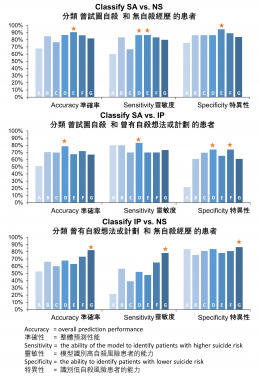Media
HKU State Key Laboratory of Brain and Cognitive Sciences study reveals brain connectivity patterns can predict suicide risk in patients with late-life depression
12 Oct 2023

(Fig. 3) The figure shows the classification performance using different features. The vertical axis indicates the prediction performance, with a higher value representing better performance. Stars highlight the highest performance. Accuracy indicates the overall prediction performance; Sensitivity indicates the ability of the model to identify patients with higher suicide risk. Specificity indicates the ability to identify patients with lower suicide risk.
A: includes age, sex, education, onset of late-life depression, episode of late-life depression and duration of late-life depression
B: includes three suicide-risk questionnaires (i.e. the Beck Scale for Suicidal Ideation, the SAD PERSONS Scale, and the Triggers of Suicidal Ideation Inventory)
C: includes functional connectivity and structural connectivity
D: includes three questionnaires and functional connectivity
E: includes three questionnaires and structural connectivity
F: includes three questionnaires and functional and structural connectivity
G: includes all figures
(Fig. 2) The figure illustrates the effectiveness of functional connectivity, structural connectivity, and machine learning in predicting suicide risk, as measured by common assessments such as the Beck Scale for Suicidal Ideation, the SAD PERSONS Scale, and the Triggers of Suicidal Ideation Inventory. The vertical axis represents the predictive performance, with larger numbers indicating better performance. Bars marked with a star signify significant predictions. (The orange bars represent positive brain connectivity, indicating a stronger connection with higher suicide risk scores. On the other hand, the blue bars represent negative brain connectivity, indicating a weaker connection with higher suicide risk scores)

(Fig. 3) The figure shows the classification performance using different features. The vertical axis indicates the prediction performance, with a higher value representing better performance. Stars highlight the highest performance. Accuracy indicates the overall prediction performance; Sensitivity indicates the ability of the model to identify patients with higher suicide risk. Specificity indicates the ability to identify patients with lower suicide risk.
A: includes age, sex, education, onset of late-life depression, episode of late-life depression and duration of late-life depression
B: includes three suicide-risk questionnaires (i.e. the Beck Scale for Suicidal Ideation, the SAD PERSONS Scale, and the Triggers of Suicidal Ideation Inventory)
C: includes functional connectivity and structural connectivity
D: includes three questionnaires and functional connectivity
E: includes three questionnaires and structural connectivity
F: includes three questionnaires and functional and structural connectivity
G: includes all figures
- 1 / 3
- 2 / 3
- 3 / 3
Suicidal ideation, plans, and behaviours are serious health threats among older adults with late-life depression, resulting in a higher likelihood of death than in any other age group. The increasing prevalence of depression in late life speaks for the urgent need for cost-effective, objective screening of suicide risk.
The current screening for suicide risk primarily relies on structured clinical interviews and questionnaires, which typically consume time and effort to complete.
A study led by Professor Tatia Lee, Director of the State Key Laboratory of Brain and Cognitive Sciences of the University of Hong Kong (HKU), revealed that brain patterns could predict suicide risk in the late-life depression population. The findings have been published in Nature Mental Health.
Professor Lee's research team utilised connectome-based predictive modelling with whole-brain resting-state functional connectivity (i.e. significantly correlated brain signals between functionally related brain regions in the absence of any stimulus or task) and white matter structural connectivity (i.e. white matter fibre tracts physically interconnecting brain regions) data to predict suicide risk. These two techniques consistently show high test - retest reliability and generalisability across study contexts. The study recruited 91 patients from a hospital diagnosed with major depressive disorder, including 37 non-suicidal patients, 24 patients with suicidal ideation/plan, and 30 patients who attempted suicide. Brain connectivity profiles were used to classify three groups in the dataset and two independent datasets using machine learning.
Patients with late-life depression were classified into three groups who had different levels of suicide risk: non-suicidal patients, patients with suicidal ideation or plans, and patients who had attempted suicide. It was found that the functional and structural connectivity profiles improved classification-prediction accuracy compared with using questionnaire scores alone and could be applied to identify depressed patients who had higher suicide risk in two independent datasets. The classification accuracy for distinguishing the three groups of patients with late-life depression ranged from 80% to 90%. Notably, the functional and structural connectivity profiles improved the accuracy by up to 8%, compared with using questionnaire scores alone. (Fig. 3)
“Suicide is the worst outcome for people with depression, haunting those who suffered the loss. We are competing with time. The earlier we can tally the risk, the sooner life-saving intervention can be in place.” Professor Lee said.
The research team highlighted that classification accuracy in distinguishing late-life depression patients with higher suicide risk from those with lower suicide risk was enhanced by considering functional and structural connectivity. They also suggested that multimodal brain connectivity could capture individual differences in suicide risk among late-life depression patients. The predictive models developed by the research team will be further tested for accurate screening for patients who need detailed assessments and interventions.
In future clinical assessments, the research team hopes to collect multimodal brain imaging, psychological, and behavioural data and integrate these data into predictive models to generate precision suicide risk scores, facilitating the design of individualised assessment and intervention programmes.
Link to the paper: https://www.nature.com/articles/s44220-022-00007-7
Media enquiries:
Miss Alice Wong, State Key Laboratory of Brain and Cognitive Sciences, HKU (Tel: 3917 1230; Email: sklbrain@hku.hk)
